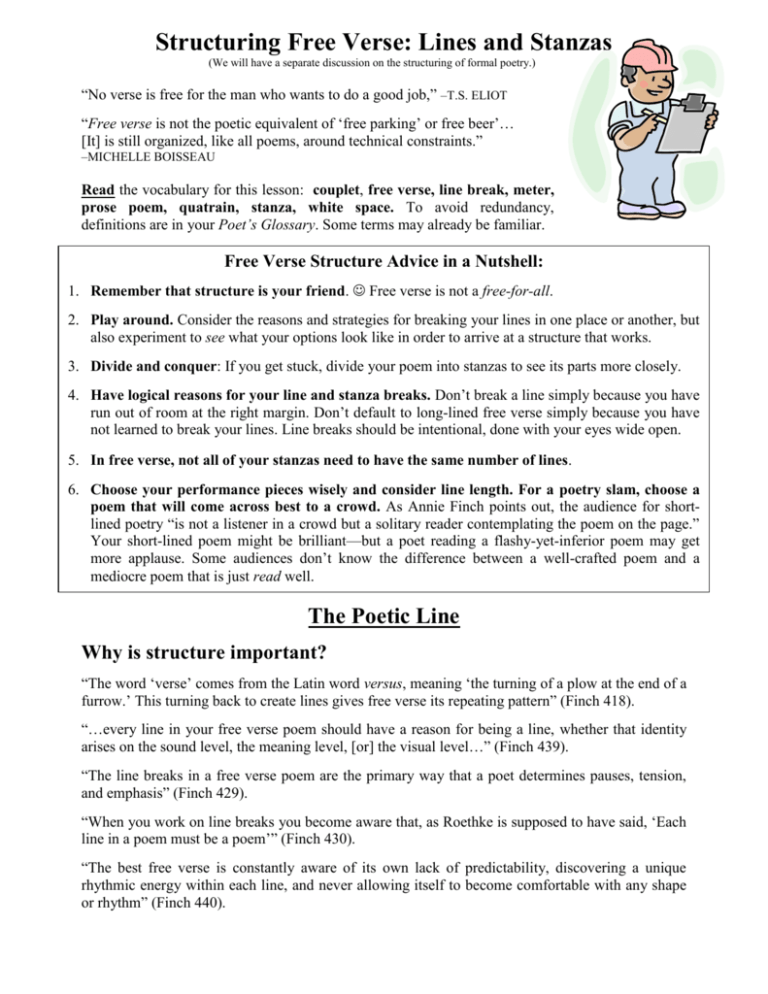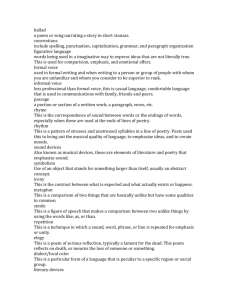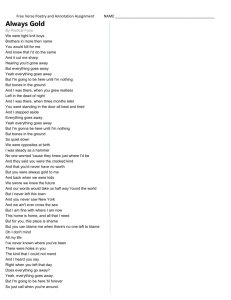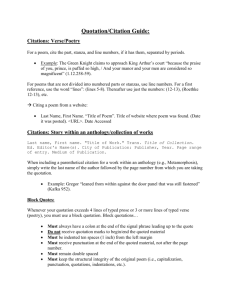Structuring Free Verse
advertisement

Structuring Free Verse: Lines and Stanzas (We will have a separate discussion on the structuring of formal poetry.) “No verse is free for the man who wants to do a good job,” –T.S. ELIOT “Free verse is not the poetic equivalent of ‘free parking’ or free beer’… [It] is still organized, like all poems, around technical constraints.” –MICHELLE BOISSEAU Read the vocabulary for this lesson: couplet, free verse, line break, meter, prose poem, quatrain, stanza, white space. To avoid redundancy, definitions are in your Poet’s Glossary. Some terms may already be familiar. Free Verse Structure Advice in a Nutshell: 1. Remember that structure is your friend. Free verse is not a free-for-all. 2. Play around. Consider the reasons and strategies for breaking your lines in one place or another, but also experiment to see what your options look like in order to arrive at a structure that works. 3. Divide and conquer: If you get stuck, divide your poem into stanzas to see its parts more closely. 4. Have logical reasons for your line and stanza breaks. Don’t break a line simply because you have run out of room at the right margin. Don’t default to long-lined free verse simply because you have not learned to break your lines. Line breaks should be intentional, done with your eyes wide open. 5. In free verse, not all of your stanzas need to have the same number of lines. 6. Choose your performance pieces wisely and consider line length. For a poetry slam, choose a poem that will come across best to a crowd. As Annie Finch points out, the audience for shortlined poetry “is not a listener in a crowd but a solitary reader contemplating the poem on the page.” Your short-lined poem might be brilliant—but a poet reading a flashy-yet-inferior poem may get more applause. Some audiences don’t know the difference between a well-crafted poem and a mediocre poem that is just read well. The Poetic Line Why is structure important? “The word ‘verse’ comes from the Latin word versus, meaning ‘the turning of a plow at the end of a furrow.’ This turning back to create lines gives free verse its repeating pattern” (Finch 418). “…every line in your free verse poem should have a reason for being a line, whether that identity arises on the sound level, the meaning level, [or] the visual level…” (Finch 439). “The line breaks in a free verse poem are the primary way that a poet determines pauses, tension, and emphasis” (Finch 429). “When you work on line breaks you become aware that, as Roethke is supposed to have said, ‘Each line in a poem must be a poem’” (Finch 430). “The best free verse is constantly aware of its own lack of predictability, discovering a unique rhythmic energy within each line, and never allowing itself to become comfortable with any shape or rhythm” (Finch 440). The Six Types of Free Verse: 1. Long-lined, oral-based free verse “Long-lined, oral-based free verse is the most ancient type. It descends from Old Testament psalms, which inspired poets such as William Blake, Christopher Smart, and eventually Walt Whitman and Allen Ginsberg. Long-lined free verse usually aims to move readers through their ears, or their internal ears (how your brain ‘hears’ words when you read silently. It lends itself to long sentences, waves and surges of sound, public or political situations, rolling rhythms, repeated phrases…high rhetoric, and grand gestures.” (Finch 420) 2. Short-lined free verse “Short-lined free verse…aims for the eye rather than the ear of the reader....This style of short-lined free verse aims for a hyper-awareness of every word on the part of the reader…Unlike in long- and medium-line free verse, these breaks tend to happen at unnatural places, such as in the middle of a phrase. The visual impact of the line breaks is crucial. It is hard to imagine this kind of free verse existing before the invention of the typewriter, since the spacing of letters, and which words end up under which words, is all-important—just as the contemplation of the calligraphy of a traditional painted Chinese poem is a key part of the experience. Simplicity is key in this twentieth-century tradition. Anything that appears artificial or clumsy can ruin the effect, including rhetoric, any kind of cliché, too much rhyme or word-music, and repeated or insistent rhythms. The audience for this type of poetry is not a listener in a crowd but a solitary reader contemplating the poem on the page. You wrap yourself around these poems; they don’t sweep you away.” (Finch 421-22) 3. Literary or medium-lined free verse “Literary or medium-lined free verse tends to aim for the mind rather than the ear or eye. This kind of poem often seems closely linked to metered poetry, and sometimes it hovers around meter. The lines tend to follow syntactic units, breaking at natural pauses between phrases. Often, such poems cultivate immediacy of tone and a plain, conversational style; the main goal is to create an emotional persona for the speaker with whom the reader can identify.” (Finch 422-23) 4. Variable-lined free verse “Variable-lined free verse is sometimes used for a whole poem, and sometimes just for certain passages that make strong expressive use of the contrast between line-lengths” (Finch 424). 5. Open field or projective free verse (might look scattered across the page) “Open field or projective free verse moves away from the line altogether. A subspecies of graphic [concrete] poetry, this kind of free verse takes the entire blank space of the page for a visual field…these techniques can add a dramatic visual and narrative dimension to a poem, in addition to the effect of the line breaks on the meanings of words and lines” (Finch 425-27). This type arranges the words and phrases across the page by using spaces, line breaks, and indentations. Both positive space (the text) and negative space (or white space) make meaning in a poem. White space can emphasize a word or phrase, give the reader room to pause, or facilitate movement between ideas. 6. Prose poems (looks like one chunky paragraph). “Prose poems…are technically not free verse at all, since they don’t use a break at the end of a line…the lack of deliberate line breaks create a relentlessness to this rush of prose. Much in these words feels like a lyric poem: the verbal interest, the clash of dictions, the amused attention to idiomatic language, and the high level of imagery. Some prose poems have a more clearly narrative coherence….Because of the lack of line breaks, some writers classify prose poems as ‘lyric prose,’ not as poetry….In my opinion, brief length, defined by the terminal hiatus, is what distinguishes a ‘prose poem’ from lyric prose” (Finch 427-429). Note: There is nothing wrong with prose poems, but I suggest you avoid writing them because beginning poets need to practice creating line breaks. Page 2 of 5 What can the focus of a line be? Enjambment: a surprising enjambment Word: the impact of a word—a word that anchors with vividness or surprise Image: a new aspect of an image Sound: a phrase full of repeating vowel and consonant sounds (i.e. alliteration and assonance) Fresh Repetition: the repetition of a word in a fresh way What effects can you create with line breaks? You can mute a word: “Line breaks can play against expectations; they can be used to emphasize a rhyme or repeating sound, or to mute it” (Finch 434). You can “mute” a word by putting it midline instead of at the end, which you might want to do if repeating a word. You can assist the logical flow: “Line breaks have a strong effect on the way a reader perceives a poem’s logic. A line break can enable the line to suggest something very different from the sentence, or even to contradict it” (Finch 435). You can highlight a sentence or phrase: “…sometimes the line breaks occur consistently at the end of sentences or phrases. This is particularly true of long-lined free verse, but it can also be an effective strategy for short-lined or variable line-length free verse” (Finch 436). You can have line breaks serve in lieu of punctuation: Line breaks can function instead of all the elements of punctuation (i.e. commas, periods, question marks, quotation marks). You can create a sense of urgency (meditative, emotional, or narrative urgency): “A poem that always breaks in the middle of a sentence or phrase (enjambment) can create a sense of unbroken flow, or a sense of urgency” (Finch 437). A closing word about free verse: “Since free verse often relies to an extra extent on imagery, and since it tries to defamiliarize familiar language with the most minimal tools, practicing free verse for a while can strengthen your eye for imagery and your ear for idiomatic diction even if you are committed to metrical poetry. On the other hand, if you are committed to free verse poetry, practicing meter will teach and strengthen your ear so you can create free verse rhythms that are alive and interesting. Many poets go through phases when they only want to write in free verse or period when they only want to write in meter. Each of these phases can be good for your poetry and can help you write the other way. Writing free verse is an excellent way to understand what goes into writing a strong poetic line, whether that line is in free verse or meter.” (Finch 442) Page 3 of 5 The Poetic Stanza Here is some helpful information about writing stanzas in free verse. There is much more to be learned about stanzas when writing in meter, but that is advanced, so we will save it for later. “The word ‘stanza’ comes from the Italian word for ‘room’ (as if a poem were a house or another building). I also like to think of stanza breaks as veins or channels that bring air and light into a poem and allow us to better experience the terrain” (Finch 447). “A poem’s stanzas are a powerful part of its first impression, so it is worth choosing them carefully. If your poem is unrhymed free verse, you can decide stanza breaks on the basis of the poem’s meaning” (Finch 450). “Stanzas work best if the breaks between them are taken seriously: honored, respected, used consciously to strengthen the transitions and meanings of a poem. It’s hard to find a good poem that doesn’t follow this principle” (Finch 448). “While meter is about structuring the poetic line, poetic form is about structuring the poem as a whole. The basic unit of form is the stanza, and most poetic forms either consist of—or, like the sonnet, evolved from—stanzas. The stanza determines how a poem can take a breath, step back and look at itself, hear itself speak. If a student of mine is completely stuck working on a poem and asks for my opinion on what to do next, more often than not they will show me a single block of text. Having learned in my own experience that often the first step toward finding the final shape of the poem I’m revising is to divide it into stanzas, I frequently advise them to break it into unit that will reflect the different movements and parts of the poem. After a poem is separated into independent parts, it’s much easier to discover its underlying structure and to experiment with different kinds of logical, narrative, or emotional order.” (Finch 447) Types of Stanzas Stanzas are given different names depending on their structure and rhyme patterns. In free verse, the names of most stanza types are easy to remember because of their numeric roots (Think of how musical performers are categorized into similar groups such as duet, trio, quartet, etc.) couplet tercet quatrain quintet/quintain/cinquain sestet/sextet/sexain septet octet/octave = a two-line stanza = a three-line stanza (called a triolet when the lines rhyme) = four-line stanza = five-line stanza = six-line stanza = seven-line stanza = eight-line stanza A continuous, unbroken stanza is called a stichic (pronounced STICK-ick). In free verse, not all of your stanzas need to have the same number of lines. It is worth noting that in metrical verse, stanza names may be associated with particular rhyme schemes, and their names may vary from those above (triplet, decima, etc.) Page 4 of 5 Shaped, Visual and Concrete Poetry Writing shaped, visual, or concrete poetry provides an added challenge for a beginning poet, and if the majority of the effort is put into the shape instead of into the imagery and other poetic devices, the poem can come across as a bit gimmicky. This is why I usually steer beginning poets away from shapes. “In shaped poetry (sometimes called “visual poetry,” or carmina figurata), the shape of a stanza is a visual aspect of the poem’s art, and a key to the poem’s meaning” (Finch 452). For example, there is a poem about wings where each stanza tapers down and then widens again. This is similar to “concrete poetry,” for example, a poem in the shape of an egg, a heart, or an umbrella. “Shaped poetry (along with concrete poetry, which uses typography and other effects to make the words of a poem works of visual art in themselves) reminds us of the centrality of visual experience to reading poetry. Though visual power is part of the impact of all stanzas, shaped or concrete poetry is the exception; most stanzas are centrally concerned with musical aspects of poetry.” (Finch 454). Review: If I were to ask you these questions, could you answer them easily? 1. 2. 3. 4. 5. What is a stanza? What are the Six Types of Free Verse? What can you center a line around in order to unify it or give it a focus? What are some of the kind of effects you can achieve with line breaks? Can you identify examples in your Poetry Anthology of the six types of free verse? (I think I haven’t included a prose poem.) 6. Can you support your reasons for your line and stanza breaks in your poems? 7. If I were to ask you to name some stanza units, could you? Page 5 of 5









